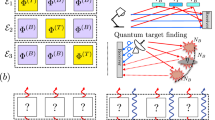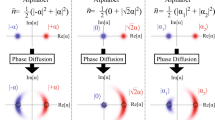Abstract
The quantum states of two laser pulses—coherent states—are never mutually orthogonal, making perfect discrimination impossible. Even so, coherent states can achieve the ultimate quantum limit for capacity of a classical channel, the Holevo capacity. Attaining this requires the receiver to make joint-detection measurements on long codeword blocks, optical implementations of which remain unknown. Here, we report the first experimental demonstration of a joint-detection receiver, demodulating quaternary pulse-position-modulation codewords at a word error rate of up to 40% (2.2 dB) below that attained with direct detection, the largest error-rate improvement over the standard quantum limit reported to date. This is accomplished with a conditional nulling receiver, which uses optimized-amplitude coherent pulse nulling, single photon detection and quantum feedforward. We further show how this translates into coding complexity improvements for practical pulse-position-modulation systems, such as in deep-space communication. We anticipate our experiment to motivate future work towards building Holevo-capacity-achieving joint-detection receivers.
This is a preview of subscription content, access via your institution
Access options
Subscribe to this journal
Receive 12 print issues and online access
$209.00 per year
only $17.42 per issue
Buy this article
- Purchase on Springer Link
- Instant access to full article PDF
Prices may be subject to local taxes which are calculated during checkout




Similar content being viewed by others
References
Holevo, A. S. The capacity of the quantum channel with general signal states. IEEE Trans. Inf. Theor. 44, 269–273 (1998).
Giovannetti, V. et al. Classical capacity of the lossy bosonic channel: the exact solution. Phys. Rev. Lett. 92, 027902 (2004).
Guha, S. Structured optical receivers to attain superadditive capacity and the Holevo limit. Phys. Rev. Lett. 106, 240502 (2011).
Wilde, M. & Guha, S. Polar codes for classical-quantum channels. Preprint at http://arXiv.org/abs/1109.2591 (2011).
Guha, S. & Wilde, M. Polar coding to achieve the Holevo capacity of a pure-loss optical channel. IEEE Int. Symp. Inf. Theory Proc. Preprint at http://arxiv.org/abs/1202.0533 (2012).
Guha, S., Dutton, Z. & Shapiro, J. H. On quantum limit of optical communications: concatenated codes and joint-detection receivers. IEEE Int. Symp. Inf. Theor. Proc. 274–278 (2011).
Lloyd, S., Giovannetti, V. & Maccone, L. Sequential projective measurements for channel decoding. Phys. Rev. Lett. 106, 250501 (2011).
Helstrom, C. W. Quantum Detection and Estimation Theory (Academic, 1976).
Dolinar, S. J. Jr. An optimal receiver for the binary coherent state quantum channel. MIT Res. Lab. Electron. Quart. Progr. Rep. 111, 115–120 (1973).
Cook, R. L., Martin, P. J. & Geremia, J. M. Optical coherent state discrimination using a closed-loop quantum measurement. Nature 446, 774–777 (2007).
Kennedy, R. S. A near-optimum receiver for the binary coherent-state quantum channel. MIT Res. Lab. Electron. Quart. Progr. Rep. 110, 219–225 (1972).
Takeoka, M. & Sasaki, M. Discrimination of the binary coherent signal: Gaussian-operation limit and simple non-Gaussian near-optimal receivers. Phys. Rev. A 78, 022320 (2008).
Wittmann, C. et al. Demonstration of near-optimal discrimination of optical coherent states. Phys. Rev. Lett. 101, 210501 (2008).
Bondurant, R. S. Near-quantum optimum receivers for the phase-quadrature coherent-state channel. Opt. Lett. 18, 1896–1898 (1993).
Tsujino, K. et al. Quantum receiver beyond the standard quantum limit of coherent optical communication. Phys. Rev. Lett. 106, 250503 (2011).
Sasaki, M., Kato, K., Izutsu, M. & Hirota, O. Quantum channels showing superadditivity in classical capacity. Phys. Rev. A 58, 146–158 (1998).
Buck, J. R., van Enk, S. J. & Fuchs, C. A. Experimental proposal for achieving superadditive communication capacities with a binary quantum alphabet. Phys. Rev. A 61, 032309 (2000).
Dolinar, S. J. Jr. A near-optimum receiver structure for the detection of M-ary optical PPM signals, The Telecommunications and Data Acquisition Progress Report 42–72, December 1982 (Jet Propulsion Laboratory, 1983).
Guha, S., Habif, J. L. & Takeoka, M. Approaching Helstrom limits to optical pulse-position demodulation using single photon detection and optical feedback. J. Mod. Opt. 58, 257–265 (2011).
Shannon, C. E. A mathematical theory of communication. Bell System Tech. J. 27, 379–423, 623–656 (1948).
Moision, B., Hamkins, J. & Cheng, M. Design of a coded modulation for deep space optical communications. Information Theory and its Applications (ITA) Workshop (University of California San Diego, 2006).
Forney, G. D. Concatenated codes, Appendix D, Research Monograph No. 37 (MIT Press, 1966).
Tan, S. H. Quantum State Discrimination with Bosonic Channels and Gaussian States. PhD thesis, Massachusetts Institute of Technology (2011).
Sen, P. Achieving the Han-Kobayashi inner bound for the quantum interference channel by sequential decoding. Preprint at http://arxiv.org/abs/1109.0802 (2011).
Wilde, M., Guha, S., Tan, S.-H. & Lloyd, S. Explicit detectors for optical communication and quantum reading. Preprint at http://arxiv.org/abs/1202.0518v2 (2012).
Acknowledgements
This work was funded by the Defense Advanced Research Projects Agency (DARPA) Information in a Photon (InPho) programme (contract no. HR0011-10-C-0159). The views and conclusions contained in this document are those of the authors and should not be interpreted as representing the official policies, either expressly or implied, of the DARPA or the US government. The authors thank M. Takeoka, National Institute of Information and Communications Technology, Japan, for useful discussions.
Author information
Authors and Affiliations
Contributions
J.C. set up the optics for the experiment and collected the data. J.L.H. set up all the required electronics and helped J.C. with data collection. Z.D. analysed the data, modelled the nulling mismatch and carried out coding overhead simulations. R.L. programmed the FPGA for feedback control. S.G. proposed the receiver concept and provided overall guidance. S.G. and Z.D. prepared the manuscript.
Corresponding author
Ethics declarations
Competing interests
The authors declare no competing financial interests.
Rights and permissions
About this article
Cite this article
Chen, J., Habif, J., Dutton, Z. et al. Optical codeword demodulation with error rates below the standard quantum limit using a conditional nulling receiver. Nature Photon 6, 374–379 (2012). https://doi.org/10.1038/nphoton.2012.113
Received:
Accepted:
Published:
Issue Date:
DOI: https://doi.org/10.1038/nphoton.2012.113
This article is cited by
-
Measurement operators for quantum coherent states in binary and quaternary photonic communications with polarization degree of freedom
Journal of Optics (2024)
-
A receiver for quadrature/polarization modulated quantum coherent states in photonic communications employing the Naimark extension
Quantum Information Processing (2023)
-
Quantum receiver enhanced by adaptive learning
Light: Science & Applications (2022)
-
Demonstration of optimal non-projective measurement of binary coherent states with photon counting
npj Quantum Information (2022)
-
Energy and bandwidth efficiency optimization of quantum-enabled optical communication channels
npj Quantum Information (2022)



